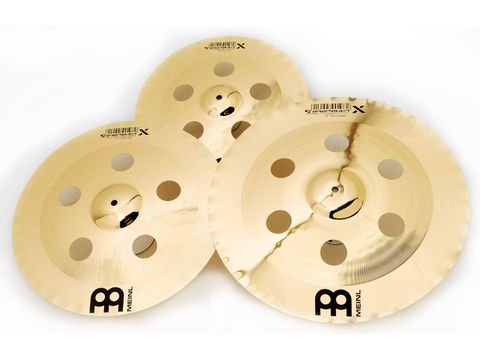First introduced in 2003, Meinl's Generation X range is an unashamedly modern take on cymbals. The range has been devised with strong input from three Meinl endorsees who share impeccable envelope-pushing credentials, namely Thomas Lang, Johnny Rabb and Benny Greb.
Virtually all the Generation X cymbals have been influenced by one if not all three of these genre-melting drummers, and now, into a range that's already noted for its unconventional models, come three more and equally iconoclastic cymbals.
Build
Available in diameters of 15", 17" and 19", the China Crashes are made from rolled sheets of B10 bronze. They are products of what Meinl describes as its high-tech computerised manufacturing process. In other words, the hammering and lathing is largely machine applied. There is no shame in this - a vast amount of mass-produced cymbals receive more attention from machines than human beings during production, despite what the manufacturers would like you to believe - and, when all is said and done, all that should matter is how a cymbal sounds.
In shape, the cymbals clearly mix elements of both crash and china-type designs. A well-proportioned and highly polished bell meets a conventional bow, which leads to an upturned china-like flange. The edge of the flange is crinkled all the way around its circumference.
"The 19" is a different proposition again, being a far louder and more aggressive cymbal, almost to the point of abrasiveness. At full tilt it delivers an ear-shredding that brings terms such as 'white noise' to mind".
This feature - which Meinl calls its 'Soundwave' edge - is usually found exclusively on hi-hats. The reason for its inclusion on these cymbals is to encourage a rapid decay. When a cymbal is hit, vibrations travel from its centre to the outside edge across the lathing and hammering patterns, circuiting the outer edge until they gradually fade. In theory, the Soundwave edge's undulations impede the progress of the vibrations, thus stifling wash.
The China Crashes are all supermodel-thin (apart from the bells, which are more substantial) and feel malleable to touch. This flexibility is undoubtedly due to the set of holes encircling the bell area of each cymbal. While being fairly uncommon, they are not unique; their purpose is to induce trashiness and attack. They work at a fundamental level, as removing portions of metal from a cymbal is guaranteed to radically alter tuning.
The holes also interrupt the energy flow across the cymbal, spiking any tonal niceties that might be harboured within the grooves. They measure 48mm in diameter, with the 15" and 17" cymbals featuring five of them and the 19" sporting a total of six.
Hands On
Though it might seem obvious that the three China Crashes would share an easily identifiable characteristic - their trashiness - they do differ from one another. The 15" model is bright and silvery to the point of being splash-like. It is so clean and high in pitch that a stab at it brings a response not unlike shattering glass, with decay being almost instant.
The 17" cymbal reveals more of its hybrid nature by displaying some traits from the conventional elements of its design. Beneath this veneer of respectability, though, lies a cutting and wonderfully trashy cymbal. The influence of the crinkled Soundwave edge is more obvious on its larger diameter; a fraction of a second after the opening blast has died away the remaining fizzy wash is suddenly choked down to a barely audible trickle. It's as though a hand has momentarily grabbed and then released the cymbal.
The 19" is a different proposition again, being a far louder and more aggressive cymbal, almost to the point of abrasiveness. At full tilt it delivers an ear-shredding that brings terms such as 'white noise' to mind. Again the Soundwave edge works its trick, compressing the decay in a spectacular fashion.
After hearing the cymbals played with force, we couldn't resist taking a bow to them. The usual technique of bowing the outer edge didn't work: the Soundwave edge prevented the bow from catching cleanly and setting off vibrations. However, locating the bow in any of the holes brought superb results. Anything from Theremin-like howls and shrieks to shuddering, unearthly moans was achieved with a degree of consistency.

